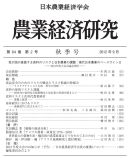All issues

Volume 81 (2009)
- Issue 4 Pages 209-
- Issue 3 Pages 155-
- Issue 2 Pages 44-
- Issue 1 Pages 1-
Volume 81, Issue 4
Displaying 1-2 of 2 articles from this issue
- |<
- <
- 1
- >
- >|
full-paper
-
An Empirical Analysis by the Dynamic Dual ModelRyo SAKAMOTO, Hitoshi KUSAKARI2010Volume 81Issue 4 Pages 209-222
Published: March 25, 2010
Released on J-STAGE: February 28, 2014
JOURNAL FREE ACCESSThe objective of this paper is to investigate the fact that an increase in risk exposure gives negative effects on the expansion of the calf-raising farm size by using a dynamic econometric model. It is empirically known that the calf-raising farms facing the risk of calf price fluctuation tend to reduce the number of beef cows to escape a shrink in their future profitability; however, most previous studies on beef production have not discussed how uncertainty concerning prices affects the investment behavior of risk-averse producers because of their intending to analyze the mechanism of beef cycle.
The main findings from the empirical results of this study imply that a ratio of risk premium to the expected calf price is 17.2% during the period calf price goes down drastically. The ratio of 17.2% is greater than the ones which are estimated in the previous studies as the case of the rice and dairy farms. In addition, a result of the decomposition analysis of the investment behavior indicates that uncertainty concerning prices induces risk averse farmers to reduce the farm size in the observation period; therefore,the variance of calf prices has significant effects on the farm size expansion as well as the expected value of calf prices.View full abstractDownload PDF (798K) -
Toru NAKAJIMA2010Volume 81Issue 4 Pages 223-234
Published: March 25, 2010
Released on J-STAGE: February 28, 2014
JOURNAL FREE ACCESSThe purpose of this paper is to analyse the relationship between the market structure of the corn exporting industry in the U.S. and the price transmission from corn cash prices at the export ports in the U.S. Gulf to CIF prices at the import ports in Japan. Based on the arguments of Asymmetric Price Transmission (APT), the market share of the U.S. grain exporting companies is investigated in order to illustrate the market structure, and the price transmission is estimated by applying the Threshold Autoregressive (TAR)Model and M (Momentum)-TAR Model.
The main conclusions are as follows. The market concentration was relatively small in the 1980s and the first half of 1990s due to restructuring and consolidation of grain exporting companies. In the last half of 1990s and the 2000s, however, the market became less competitive and the market concentration got larger. The inference results using TAR and M-TAR models show that corn prices were transmitted more rapidly when the input-output price differences were squeezed than when they were stretched, which is so called positive APT, in the sample of the last half of 1990s and the 2000s, although the corn prices were transmitted symmetrically in the sample of the 1980s and the first half of 1990s. The Error Correction Model (ECM), in which the results of inferences by using TAR and M-TAR models were incorporated, was applied to find which factors have impacts on CIF import price changes. It was revealed that the Gulf cash prices mainly 3 months ago and the ocean freight rates 2-3 months ago most significantly affected the changes in CIF prices.View full abstractDownload PDF (704K)
- |<
- <
- 1
- >
- >|